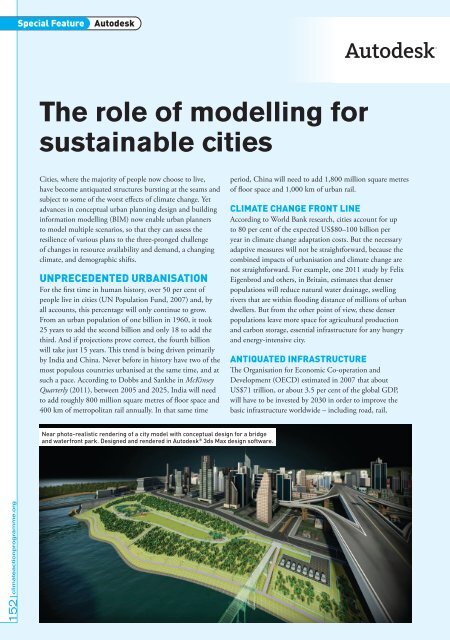Climate Action 2011-2012
Create successful ePaper yourself
Turn your PDF publications into a flip-book with our unique Google optimized e-Paper software.
special feature<br />
autodesk<br />
CA<strong>2011</strong> Exxaro_2.pdf<br />
The role of modelling for<br />
sustainable cities<br />
Cities, where the majority of people now choose to live,<br />
have become antiquated structures bursting at the seams and<br />
subject to some of the worst effects of climate change. Yet<br />
advances in conceptual urban planning design and building<br />
information modelling (BIM) now enable urban planners<br />
to model multiple scenarios, so that they can assess the<br />
resilience of various plans to the three-pronged challenge<br />
of changes in resource availability and demand, a changing<br />
climate, and demographic shifts.<br />
Unprecedented Urbanisation<br />
For the first time in human history, over 50 per cent of<br />
people live in cities (UN Population Fund, 2007) and, by<br />
all accounts, this percentage will only continue to grow.<br />
From an urban population of one billion in 1960, it took<br />
25 years to add the second billion and only 18 to add the<br />
third. And if projections prove correct, the fourth billion<br />
will take just 15 years. This trend is being driven primarily<br />
by India and China. Never before in history have two of the<br />
most populous countries urbanised at the same time, and at<br />
such a pace. According to Dobbs and Sankhe in McKinsey<br />
Quarterly (<strong>2011</strong>), between 2005 and 2025, India will need<br />
to add roughly 800 million square metres of floor space and<br />
400 km of metropolitan rail annually. In that same time<br />
period, China will need to add 1,800 million square metres<br />
of floor space and 1,000 km of urban rail.<br />
climate change front line<br />
According to World Bank research, cities account for up<br />
to 80 per cent of the expected US$80–100 billion per<br />
year in climate change adaptation costs. But the necessary<br />
adaptive measures will not be straightforward, because the<br />
combined impacts of urbanisation and climate change are<br />
not straightforward. For example, one <strong>2011</strong> study by Felix<br />
Eigenbrod and others, in Britain, estimates that denser<br />
populations will reduce natural water drainage, swelling<br />
rivers that are within flooding distance of millions of urban<br />
dwellers. But from the other point of view, these denser<br />
populations leave more space for agricultural production<br />
and carbon storage, essential infrastructure for any hungry<br />
and energy-intensive city.<br />
antiqUated infrastrUctUre<br />
The Organisation for Economic Co-operation and<br />
Development (OECD) estimated in 2007 that about<br />
US$71 trillion, or about 3.5 per cent of the global GDP,<br />
will have to be invested by 2030 in order to improve the<br />
basic infrastructure worldwide – including road, rail,<br />
Near photo-realistic rendering of a city model with conceptual design for a bridge<br />
and waterfront park. Designed and rendered in Autodesk ® 3ds Max design software.<br />
152 climateactionprogramme.org












